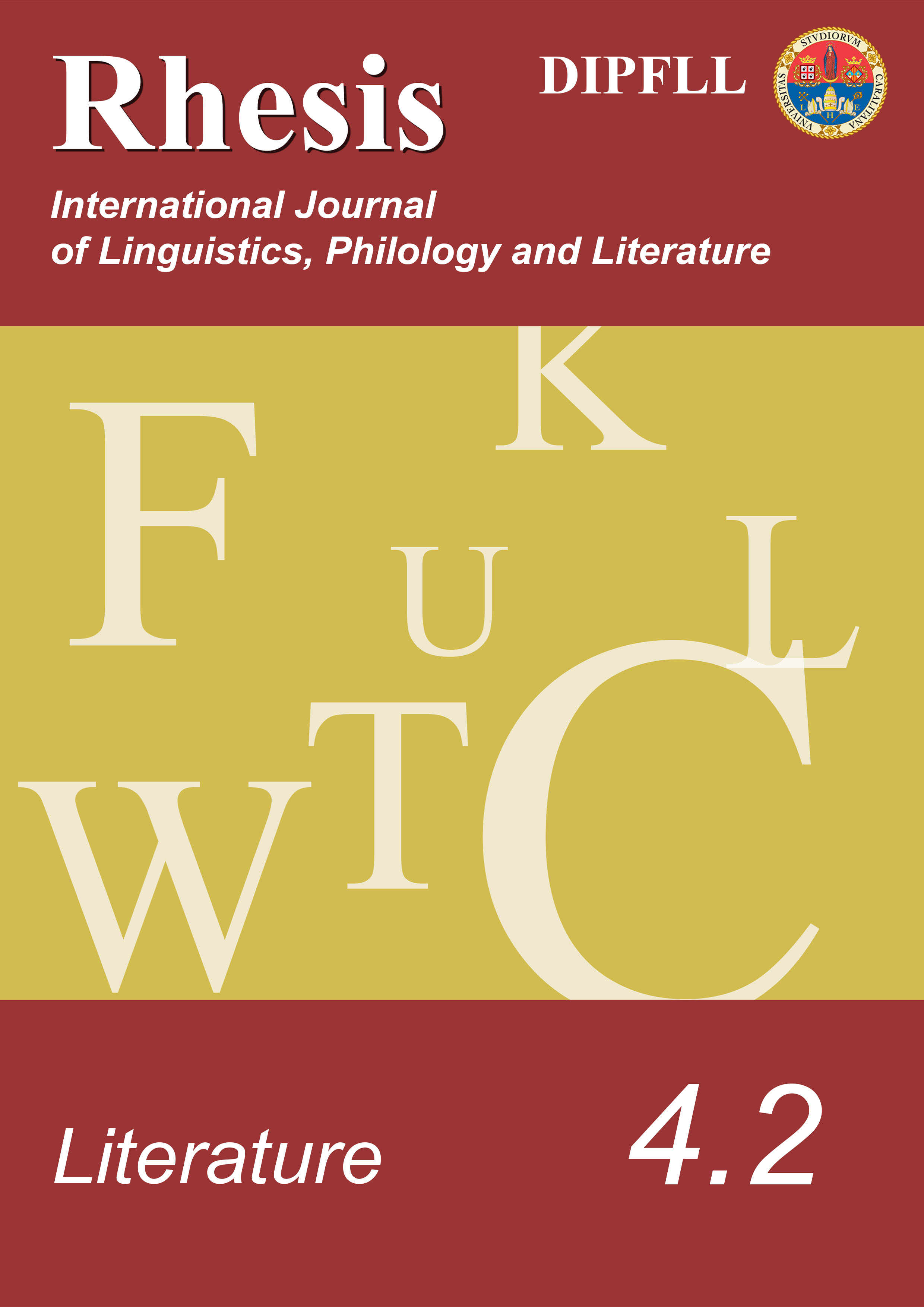Prosopopea, allegoria e forze tematiche nei romanzi di Chrétien de Troyes
Abstract
Based on a definition of allegory which combines personification (subject) and metaphor (action), the paper discusses some key-episodes of Chrétien de Troyes’ Chevalier de la Charrette and Chevalier au Lion so as to show when the combination is truly functional to the development of an allegorical framework. At the same time, it will be shown that all presented cases denote the emergence, on the surface of the text, of the thematic drives that support the dramatic development of these romances, in order to clarify the crucial relevance of given episodes. Typically, Chrétien makes use of allegory when it comes to summarizing in categorical terms the details of a dilemma, that is when the protagonist is required to take responsibility for a dramatic choice or when he finds himself in an apparently paradoxical situation resulting from choices he previously made. Textual evidence will show that Chrétien makes use of the abstractum agens in order to emphasize congruence between matiere and sen, that is the situations described in respect to the thematic framework that substantiates his romances.
Downloads
References
Chrétien de Troyes, Le chevalier de la Charrette (Lancelot), eds. Alfred FOULET, Karl D. UITTI, Paris, Classiques Garnier, 1989.
Chrétien de Troyes, Erec et Enide, in Chrétien de Troyes, Oeuvres complètes, ed. Peter F. DEMBOWSKI, Paris, Gallimard, 1994, pp. 1-169.
Chrétien de Troyes, Yvain ou Le Chevalier au Lion, in Chrétien de Troyes, Oeuvres complètes, eds. Karl D. UITTI, Philippe WALTER, Paris, Gallimard, 1994, pp. 337-503.
FARAL, Edmond, Les arts poétiques du XIIe et XIIIe siècle, Champion, Paris, 1923.
FUKSAS, Anatole Pierre, “Selezionismo e conjointure”, in ABRUZZESE, Alberto, PEZZINI, Isabella (eds.), Dal Romanzo alle reti (Atti del Convegno «Soggetti e territori del romanzo» Università di Roma «La Sapienza». Facoltà di Scienze della Comunicazione, 23-24 maggio 2002), Torino, Testo & Immagine, 2004, pp. 152-184.
FUKSAS, Anatole Pierre, “Characters, Society and Nature in the Chevalier de la Charrette (vv. 247-398)”, «Critica del Testo», 12.2-3 (2009), pp. 49-77; Versione italiana: “Personaggi, società e natura nel Chevalier de la Charrette di Chrétien de Troyes (vv. 247-398)”, in BENOZZO, Francesco, BRUNETTI, Giuseppina, CARAFFI, Patrizia, FASSÒ, Andrea, FORMISANO, Luciano, GIANNINI, Gabriele, MANCINI, Mario (eds.), Culture, livelli di cultura e ambienti nel Medioevo occidentale, Roma, Aracne, 2012, pp. 439-470.
GLASSER, Richard, “Abstraktum agens und Allegorie im ältern Französisch”, «Zeitschrift für Romanische Philologie», 69 (1953), pp. 43-122.
JUNG, Marc René, Etudes sur le poème allégorique en France au Moyen Âge, Berne, Franke, 1971.
Kristian von Troyes, Erec und Enide, ed. Wendelin FOERSTER, Halle, Niemeyer, 19092.
LACY, Norris J., “Thematic Structure in the ‘Charrette’”, «L’Esprit créateur», 12 (1972), pp. 13-18.
LACY, Norris J., “Spatial form in Medieval Romance”, in HAIDU, Peter (ed.), Approaches to Medieval Romance, «Yale French Studies», 51 (1975), pp. 160-169.
LACY, Norris J., “Typology and Analogy”, in Authors and Philosophers, Columbia, University of South Carolina, 1979, pp. 126-130.
LAUSBERG, Heinrich, Handbuch der literarischen Rhetorik, München, Hueber, 1960.
LEWIS, Clive Staples, The Allegory of Love. A Study in Medieval Tradition, Oxford, The Clarendon Press, 1936.
MEYER, Kajsa, Transcription synoptique des manuscrits et fragments du Chevalier au Lion par Chrétien de Troyes, Université d’Ottawa, Faculté des Arts, Laboratoire de français ancien, 2006 ‹http://www.uottawa.ca/academic/arts/lfa/activites/textes/kmeyer/kpres.html›.
MUSCATINE, Charles, “The Emergence of Psychological Allegory in Old French Romance”, «Publication of The Modern Language Association», 68. 5 (1953), pp. 1160-1182.
NYKROG, Per, Chrétien de Troyes: romancier discutable, Genève, Droz, 1996.
PIRAPREZ, Delphine, “Chrétien de Troyes, allégoriste malgré lui? Amour et allégorie dans Le Roman de la Rose et Le Chevalier de la Charrette”, in DOR, Juliette (ed.), Conjointure arthurienne, Actes de la “Classe d’excellence” de la Chaire Francqui 1998. Liège, 20 février 1998, Louvain-la-Neuve, Université Catholique de Louvain - Publications de l’Institut d’Etudes médiévales, 2000 (Textes-Etudes-Congrès, 20), pp. 83-94.
RIBARD, Jacques, Chrétien de Troyes, Le Chevalier de la Charrette: Essai d'interpretation symbolique, Paris, Nizet, 1972.
RIBARD, Jacques, “Les romans de Chrétien de Troyes sont-ils allégoriques?”, «Cahiers de l’Association Internationale des Études Françaises», 28 (1976), pp. 7-20.
STRUBEL, Armand, La rose, Renart et le Graal: la littérature allégorique en France au XIIIe siècle, Genève-Paris, Slatkine, 1989.
STRUBEL, Armand, «Grant senefiance a»: Allégorie et littérature au Moyen Âge, Paris, Champion, 2002.
VINAVER, Eugène, “Principles of Textual Emendation”, in Studies in French Language and Mediaeval Literature Presented to Professor Mildred K. Pope, Manchester, Manchester University Press, 1939.



